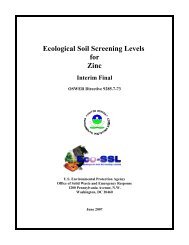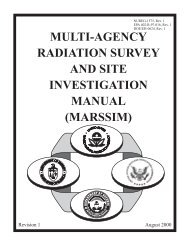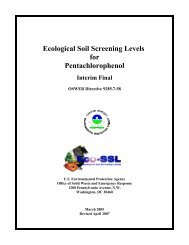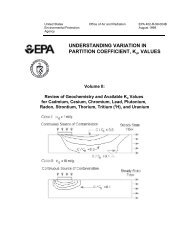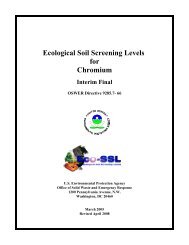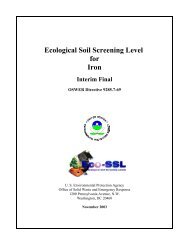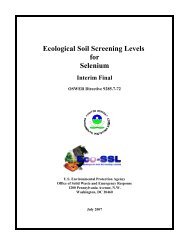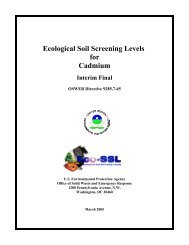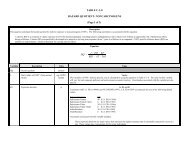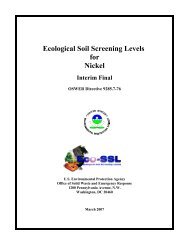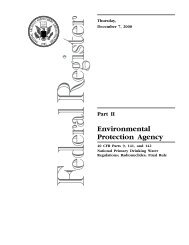Guidance for Conducting Risk Assessments and Related Risk ...
Guidance for Conducting Risk Assessments and Related Risk ...
Guidance for Conducting Risk Assessments and Related Risk ...
You also want an ePaper? Increase the reach of your titles
YUMPU automatically turns print PDFs into web optimized ePapers that Google loves.
individual. This evaluation results in the generation of exposure scenarios. Exposure scenarios represent<br />
the combination (if applicable) of exposure pathways <strong>for</strong> an individual based on his/her activity patterns.<br />
4.2.3 Quantification of Exposure<br />
Although exposure concentrations are based on the measured environmental concentrations <strong>for</strong> both<br />
current <strong>and</strong> future l<strong>and</strong> use considerations, they often display variability between different sites within a<br />
watershed. It is important to underst<strong>and</strong> that medium- <strong>and</strong> site-specific considerations influence the<br />
derivation of the exposure concentration. These considerations include the size of the site, l<strong>and</strong> use<br />
designation, techniques used <strong>for</strong> data aggregation, <strong>and</strong> selection of applicable spatial statistics. Detailed<br />
guidance <strong>for</strong> determining the area of exposure units, exposure concentrations, <strong>and</strong> related issues is<br />
provided in Appendix G.<br />
It should be noted that fate <strong>and</strong> transport modeling may be required to estimate exposure<br />
concentrations in the future. The project team should determine if fate <strong>and</strong> transport modeling would<br />
benefit the overall project <strong>and</strong> the associated risk assessment. Potential site-specific modeling decisions<br />
should be made in association with Data Quality Objective (DQO) decisions to ensure that models will be<br />
supplemented by sampling data <strong>and</strong> effectively support risk assessment activities. Appendices D-F<br />
provide guidelines on air dispersion modeling, groundwater modeling, <strong>and</strong> food chain models <strong>for</strong> use in<br />
risk assessment.<br />
Exposure concentrations serve as one input variable in the equations that are used to calculate<br />
pathway-specific intakes <strong>for</strong> each receptor. As previously mentioned, many of the exposure equations<br />
that support the l<strong>and</strong> uses on the ORR <strong>and</strong> at Paducah <strong>and</strong> Portsmouth are available on the RAIS along<br />
with default parameter values. These equations are updated as new technical in<strong>for</strong>mation becomes<br />
available.<br />
4.3 TOXICITY ASSESSMENT<br />
The purpose of a toxicity assessment is to weigh available evidence regarding the potential <strong>for</strong> a<br />
chemical to cause adverse effects in exposed individuals <strong>and</strong> to provide, where possible, an estimate of<br />
the relationship between the extent of exposure <strong>and</strong> the increased likelihood <strong>and</strong>/or severity of adverse<br />
effects. (EPA 1989) Toxicity values <strong>for</strong> carcinogenic <strong>and</strong> noncarcinogenic chemicals <strong>and</strong> radionuclides<br />
are available <strong>for</strong> use by all subcontractors per<strong>for</strong>ming work <strong>for</strong> the DOE-ORO via the RAIS. Toxicity<br />
profiles <strong>for</strong> a select set of chemicals are also available via the RAIS.<br />
4.3.1 Toxicity Values<br />
A database of chemical-specific toxicity values is maintained on the RAIS. The toxicity values<br />
database contains in<strong>for</strong>mation obtained from the EPA's Integrated <strong>Risk</strong> In<strong>for</strong>mation System (IRIS), the<br />
Health Effects Assessment Summary Tables (HEAST), <strong>and</strong> other in<strong>for</strong>mation sources; all in<strong>for</strong>mation<br />
contained in the database is referenced. In addition, the database contains supplemental in<strong>for</strong>mation<br />
clarifying some issues.<br />
The toxicity values contained in the RAIS database were developed <strong>for</strong> human health risk<br />
evaluations <strong>and</strong> assessments utilizing methods presented in part A of <strong>Risk</strong> Assessment <strong>Guidance</strong> <strong>for</strong><br />
Superfund: Volume 1-Human Health Evaluation Manual (EPA 1989). The toxicity values database<br />
contains footnoted entries <strong>for</strong> toxicity values that have been withdrawn from IRIS, are provisional, or<br />
have been derived from other in<strong>for</strong>mation. These footnoted values have been approved (by EPA Region<br />
IV) <strong>for</strong> use in the risk assessment <strong>and</strong> evaluation of areas on the ORR <strong>and</strong> Paducah. In addition, the<br />
26



